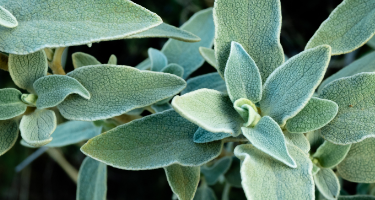
Watchlist
You can print out your watchlist and use it as a reminder for your purchase in the pharmacy.
Your watchlist currently contains no products.
Print


Greek sage
Greek sage
Botanik
Greek sage (lat. Salvia triloba or Salvia fruticosa), also known as three-lobed sage, is a perennial plant of the Lamiaceae family native to the Mediterranean region. Thanks to its aromatic scent, the shrub or semi-shrub of sage is used as a medicinal and aromatic plant. Our variety originates from the almost untouched nature of the monastic republic of Mount Athos, but is also widespread in central and eastern Mediterranean areas such as Italy, the former Yugoslavia, Albania, Greece, Turkey and Lebanon. It grows on dry, rocky limestone soils or the edges of pine forests, riverbeds and roadsides at altitudes of 100 to 800 meters above sea level.
The branched, evergreen shrub or semi-shrub is characterized by its aromatic scent, which reaches heights of 0.3 to 1.5 metres. The stems are initially covered in gray felt-like hairs, are sturdy and upright and become glandular and sticky towards the upper end.
The leaves are divided into petiole and leaf blade and are arranged cross-oppositely and the leaf blades are simple or divided by three or five leaf segments. Narrow and ovate leaflets (up to 5 cm) adorn the plant, while the lateral leaflets are usually much shorter. Green and wrinkled on the upper side, the leaflets are gray-felt on the underside and usually have a wavy, finely notched leaf edge.
mehr
Geschichte
Greek sage has been used in traditional medicine since ancient times. The first records attesting to its use possibly date back to 1400 BC. Traditionally, the leaves of sage are used as a herbal tea by infusing them in hot boiling water for 3-5 minutes. It is valued above all for its spicy, slightly bitter note.
mehr
Inhaltsstoffe
Rosmarinic acid is the main substance. In addition to 1,8 cineole and camphor, it also contains α-terpineol, β-myrcene, camphene, β-pinene and α-pinene.
mehr
Eigenschaften
According to the EFSA (European Food Safety Authority), the following positive health claims for Greek sage are available for official testing:
Soothing and pleasant effect on throat, pharynx and vocal cords.
mehr
Produkte mit Greek sage
Salviathos®Bio Griechischer Salbei Tee
New in your pharmacy!
